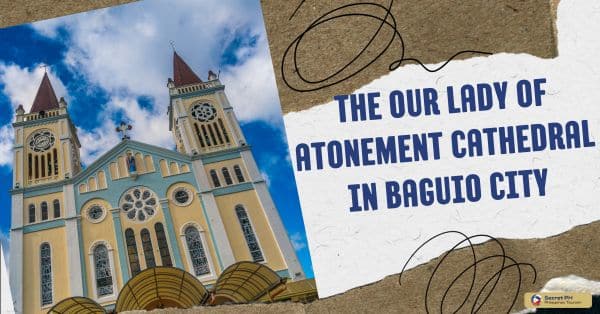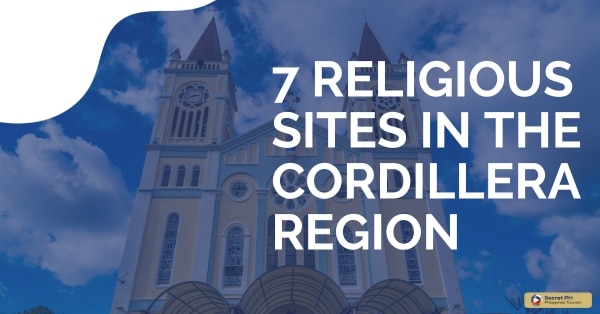Are you looking to explore the spiritual side of the Philippines? From ancient temples to modern churches, the country is home to some of the most beautiful religious sites in Asia. This blog post will show you 10 of the best religious sites in the Philippines that are definitely worth visiting.
You’ll learn about their history, culture, and why they are so important to the Filipino people. So, let’s take a look at what the Philippines has to offer in terms of religious tourism!

Cebu’s Basilica del Santo Niño
The Basilica del Santo Niño de Cebu is a Roman Catholic church located in the city of Cebu in the Philippines. It is dedicated to the Santo Niño de Cebu, a religious relic that is believed to be the oldest religious relic in the country, dating back to the arrival of the Spanish conquistadors in the 16th century.
The church was built in 1565 by Spanish explorers led by Miguel López de Legazpi and is considered the oldest stone church in the country.
The Basilica del Santo Niño de Cebu is a popular tourist destination and an important pilgrimage site for Catholics in the Philippines. The church is known for its historical significance and the annual Sinulog Festival, which is held every January to honor the Santo Niño.
Tourists can also visit the Basilica’s museum, which houses a collection of religious artifacts and artworks. Visitors can also take a guided tour of the church to learn more about the history and significance of Santo Niño and the role it played in the Philippines’ religious and cultural history.

Manila’s Minor Basilica of the Black Nazarene
The Manila’s Minor Basilica of the Black Nazarene (also known as the Quiapo Church) is the most iconic Catholic church in the Philippines. Situated in the heart of downtown Manila, it has been venerated for centuries by devotees and pilgrims alike.
The shrine dates back to 1608 when a Mexican priest brought an image of a darkly skinned child Jesus from Mexico. From then on, this image was known as “El Señor Negro” or The Black Nazarene and rapidly gained devotion from all over the country. The church is also home to more than twenty chapels in which devotees can pray privately.
The Minor Basilica is one of the top tourist destinations for its historical significance, beautiful architecture, and spiritual vibrancy. Every year during the Feast of the Black Nazarene (on January 9), millions of people come to pay homage to El Señor Negro in a traditional religious procession.
Visiting it is a must-do experience while in Manila and will surely leave you with a deep sense of appreciation for Filipino culture and history.

Batangas’ Taal Basilica
The Taal Basilica, located in the town of Talisay in Batangas, is one of the largest Catholic churches in the Philippines. It was built between 1572 and 1755 from a combination of baroque, neoclassical, and oriental-inspired architecture. The chapel boasts an impressive interior made up of wood carvings, paintings, stained glass windows, and frescoes depicting Biblical scenes.
The basilica is well known for its stunning clock tower which chimes every hour to remind visitors that time passes quickly. It is also home to a bell tower housing five bells which were gifted by Pope Pius IX in 1859.
Visiting the Taal Basilica is a great way to explore Filipino culture and history as it stands as an exceptional example of the fusion between Chinese, Spanish, and Filipino cultures. There are also several nearby attractions such as hiking trails and magnificent views of Taal Lake where visitors can spend their day exploring Batangas’ natural beauty.

Laguna’s Saint Anne Parish Church
The Saint Anne Parish Church, also known as the Liliw Church, is a historic Catholic church located in the town of Liliw, Laguna, Philippines. It was built in the 18th century and is known for its unique architectural style, which combines elements of traditional Filipino and Spanish design.
The church is dedicated to Saint Anne, the mother of the Virgin Mary, and is considered one of the oldest churches in the province of Laguna.
Tourists should visit the Saint Anne Parish Church because of its historical and cultural significance. The church is a great example of the fusion of different architectural styles, and it is a testament to the rich history and culture of the Philippines.
The church is also home to a number of religious artifacts and paintings, making it a perfect destination for those who are interested in religious and cultural heritage. The church is also located in the beautiful town of Liliw, known for its footwear and handicrafts, which make it a perfect spot for shopping and sightseeing.

Ilocos Norte’s Saint James the Apostle Parish Church
The Saint James the Apostle Parish Church in Ilocos Norte is a stunning example of colonial-era architecture. Located in the center of Laoag City, it was built by the Augustinian friars between 1612 and 1690. The church complex features three structures, each composed of different building materials – stone for the walls, tiles for the roof, and wood for the interiors.
The church also houses a Spanish clock, which is one of only two in Ilocos Norte that was made by Spanish colonizers during their rule. Inside are several ancient paintings depicting scenes from the Bible and religious artifacts that represent a unique combination of cultures.
Visiting the Saint James Parish Church is an excellent way to experience the historic colonial period in Ilocos Norte. Tourists can admire its majestic architecture, explore its diverse collections of relics and learn about how Christianity has shaped Filipino culture over centuries.

Pangasinan’s Saint Michael the Archangel Parish
The Saint Joseph the Worker Parish in Nueva Ecija is a prominent landmark among Filipino Catholics. It was established in 1768 by Franciscan friars and has served as an important religious site ever since. The church is renowned for its Baroque architecture, which is still intact despite centuries of wear and tear.
Inside the parish lies a beautiful statue dedicated to St. Joseph, built-in 1700. This statue is believed to have miraculous powers, drawing thousands of pilgrims each year who wish to seek blessings from St. Joseph himself.
Visiting this historic site provides tourists with an opportunity to get insight into the spiritual history of Nueva Ecija and experience its vibrant culture firsthand. Aside from admiring its impressive architecture and sculptures, visitors can also take part in local celebrations such as novenas, mass ceremonies, and other activities held throughout the year.

Nueva Ecija’s Saint Joseph the Worker Parish
The Saint Joseph the Worker Parish in Nueva Ecija is an important landmark for Filipino Catholics. It was established in 1768 by Franciscan friars and has been a holy site ever since. This majestic church is renowned for its Baroque architectural style and still maintains its impressive appearance despite centuries of wear and tear.
Inside the parish lies a beautiful statue dedicated to St. Joseph, built-in 1700. This statue is believed to be miraculous, attracting thousands of pilgrims each year who wish to seek blessings from St. Joseph himself.
Visiting this historic site provides tourists with an opportunity to get insight into the spiritual history of Nueva Ecija and experience its vibrant culture firsthand. In addition to admiring its impressive architecture, visitors can also take part in local celebrations such as novenas, mass ceremonies, and other activities held throughout the year.

Cavite’s Saint Martin of Tours Parish
The Saint Martin of Tours Parish in Cavite is a must-visit for anyone wishing to experience the culture and spirituality of Filipino Catholicism. First established in 1611 as a simple chapel, it was eventually transformed into a massive church during the 19th century. It stands out amongst other churches due to its distinct Baroque-Romanesque architecture and large dome that can be seen from afar.
The parish is home to many important symbols and artifacts, including an ornate statue of St. Martin himself that dates back to 1792. The church also hosts regular mass ceremonies, novenas and prayer meetings throughout the year.
Visiting the Saint Martin of Tours Parish gives tourists an opportunity to immerse themselves in the rich local culture and learn more about Philippine history. With its stunning architecture and breathtaking sculptures, visitors can be sure to have a memorable experience here.

Baclaran Church
The Baclaran Church, also known as the Redemptorist Church, is an impressive house of worship located in Parañaque City. Built-in 1941 by the Congregation of the Most Holy Redeemer (the Redemptorists), it was meant to serve as a spiritual base for Catholics from all over Metro Manila. Today, it is one of the largest and most visited churches in the city due to its proximity to the nearby airport.
The architecture of Baclaran Church is unique and eye-catching, with its simple yet striking curved shape that stands out amongst other churches in the area. Inside are two beautiful chapels, each dedicated to different saints: St. Jude Thaddeus and Our Lady of Perpetual Help. The church also hosts regular activities such as novenas, mass ceremonies, seminars, and retreats throughout the year.
Tourists should visit the Baclaran Church, not just for its historical significance but also to explore its vibrant local culture and spirituality. With a fantastic atmosphere and friendly staff on hand to provide assistance if needed, visitors can be sure they will have an enriching experience while here.

In conclusion
The Philippines is an incredibly spiritual destination, with an abundance of religious sites and artifacts that have been significant to Filipino culture for centuries. From ancient temples to magnificent churches, the country has some of the most beautiful religious sites in Asia. This blog post has shown you 9 of the best religious sites in the Philippines that are definitely worth visiting.








